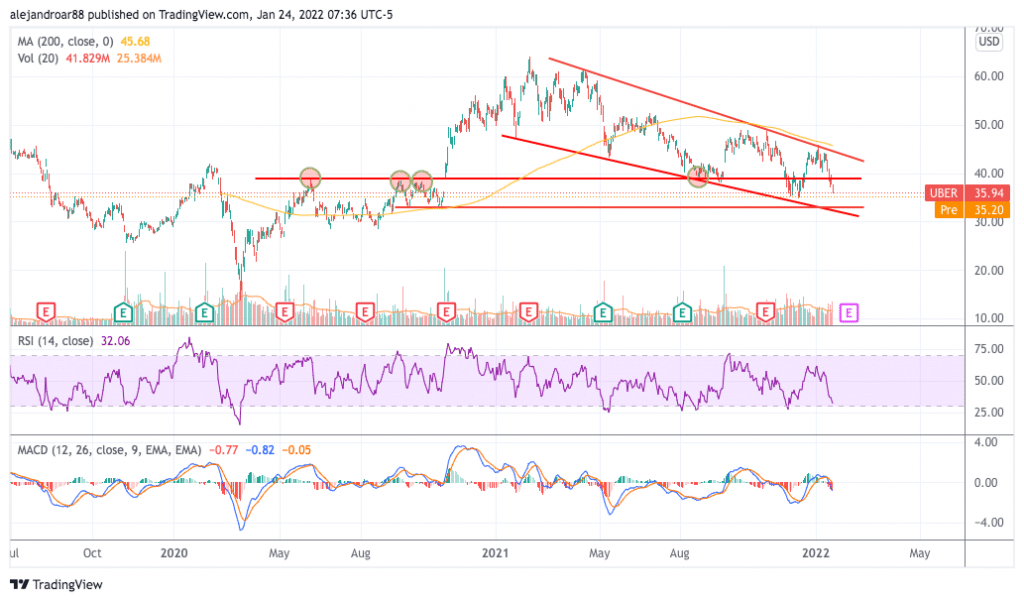Uber Stock Down 14% in January – Time to Buy UBER Stock?
Please note that we are not authorised to provide any investment advice. The content on this page is for information purposes only.
The price of Uber stock has declined more than 14% so far this month as concerns about the impact that a surge in COVID-19 cases in the United States and other latitudes along with deteriorating macro conditions have weighed on the valuation of the ride-hailing business.
As per data from Worldometers, the number of virus cases in the United States has spiked to the highest level seen since the health crisis started with over 700,000 people getting infected daily.
Meanwhile, despite vaccinations, the number of deaths has also been increasing in the past few days with an average of 2,000 people succumbing to the illness every day.
Even though authorities have not moved to impose the kind of mobility restrictions seen in 2020 to contain the spread, Uber’s main business – ride-hailing – is expected to be affected as a large group of people may decide to stay home while this latest wave passes.
Moreover, expectations about multiple upcoming interest rate hikes from the Federal Reserve and an elevated inflation rate are weighing on the valuation of risky assets including equities.
This morning, the yield of the US 10-year Treasury Notes is standing at 1.738%. In the past few days, yields have climbed above the 1.80% level for the first time since the pandemic started as bond holders keep dumping their holdings amid the country’s elevated inflation rate.
For companies like Uber, whose business model requires extensive amounts of capital to operate amid its elevated cash burn, the market is demanding a higher risk premium as the risk-free rate (typically the 10-year yield) is surging and this is causing a decline in its valuation.
What could be expected from the company headed by Dara Khosrowshahi in this current environment? In this article, we will be assessing the price action and fundamentals of this tech stock to outline plausible scenarios for the future.
67% of all retail investor accounts lose money when trading CFDs with this provider.
Uber Stock – Technical Analysis

Back in December when I last wrote about Uber, I highlighted that the outlook for the stock was bullish as long as the uptrend moved above the $50 threshold. However, it seems that sentiment was still rather negative despite the positive catalysts that were pushing the price higher back then as such a move did not materialize.
Instead, the price has remained on a downtrend after rejecting a move above the 200-day simple moving average for the first time and this demonstrates the overall weakness that the company’s valuation is experiencing.
Right now, the price is nearing an important area of support at $33. A decline below this marker could signal the continuation or acceleration of the downtrend as this is an area of confluence between a horizontal and trend line support.
Momentum indicators remain quite bearish as the Relative Strength Index (RSI) is standing at 32 (bearish) while the MACD has moved to negative territory and crossed below the signal line.
All things considered, the outlook for Uber stock is bearish and investors should keep an eye on the $33 level as a break below this area could increase downside risks significantly in the short to mid-term.
Uber Stock – Fundamental Analysis
Uber will be hosting two important events in February that could influence the price action. First, the company will be reporting its financial results covering the fourth quarter of 2021 on 9 February.
Based on data from Seeking Alpha, analysts are expecting to see revenues of around $5.4 billion and losses per share of $0.34 for the period. However, market participants will likely focus on the management’s comments concerning the impact of the omicron variant on its operations.
Moreover, on 10 February, the firm will be hosting its Investor Day. The volatility of the stock in this next month may therefore be high as any positive or negative announcements could lead to a dramatic spike in trading volumes.
By the end of the third quarter of 2021, Uber had $6.5 billion in cash and equivalents although the sale of its stake in Didi Global may have increased those cash reserves in the past 3 months. Meanwhile, in the past 12 months, the firm burned around $1.5 billion in cash.
Nothing indicates that Uber will need to raise capital immediately which means that dilution and solvency risks are low. However, the market might react negatively if the firm’s cash burn accelerates.
At its current market capitalization of $69.8 billion, the firm is trading at less than 3 times its forecasted sales for 2022. Even though this ratio is quite low for such an innovative firm, it might be justified considering the current macro environment and the firm’s still unfeasible business model.






